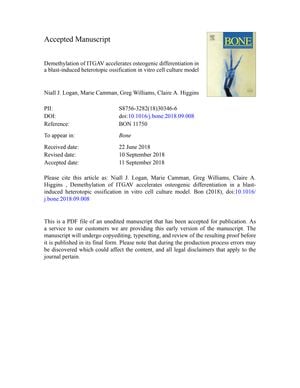TLDR Removing a methyl group from the ITGAV gene speeds up bone formation in a specific type of bone disease model.
The document from December 2018 presents a study on the molecular mechanisms of heterotopic ossification (HO), particularly following blast injuries. The researchers used an in vitro cell culture model with human mesenchymal cells and found that a single high-energy shock wave led to increased transcription of osteogenic master regulators and accelerated cell mineralization. They discovered that the shock wave caused demethylation of gene promoters, notably the ITGAV gene, which resulted in increased transcription and osteogenic differentiation. The study showed that the drug cilengitide, an ITGAV inhibitor, could prevent mineral deposition, suggesting a potential therapeutic approach for HO. The study involved RT-qPCR validation with N=4 samples and a cilengitide concentration viability/proliferation test with n=4 for BM-MSCs and n=6 for mineral deposition quantification. The findings suggest that DNA methylation changes play a significant role in osteogenic differentiation and that DP cells can be used as a model to study HO and identify therapeutics.
 55 citations
,
April 2017 in “Experimental Dermatology”
55 citations
,
April 2017 in “Experimental Dermatology” The document describes a way to isolate and grow human hair follicle cells in 3D to help study hair growth.
 30 citations
,
March 2017 in “ACS biomaterials science & engineering”
30 citations
,
March 2017 in “ACS biomaterials science & engineering” Hair follicles are valuable for regenerative medicine and wound healing.
1235 citations
,
December 2013 in “Nature” Two fibroblast types shape skin structure and repair differently.
28 citations
,
November 2013 in “Cell and Tissue Research”  321 citations
,
December 2009 in “Journal of Dermatological Science”
321 citations
,
December 2009 in “Journal of Dermatological Science” Dermal cells are key in controlling hair growth and could potentially be used in hair loss treatments, but more research is needed to improve hair regeneration methods.
151 citations
,
February 2006 in “Stem Cells and Development” Hair follicles can be a good source of stem cells like those from bone marrow.
38 citations
,
April 2005 in “Journal of Investigative Dermatology” 268 citations
,
December 2003 in “Experimental Dermatology” Hair follicle cells can become fat and bone cells.
 6 citations
,
January 2020 in “Methods in molecular biology”
6 citations
,
January 2020 in “Methods in molecular biology” The method successfully isolates cells that are important for hair growth and could help study hair loss.
488 citations
,
July 2021 in “Cell” Fibroblasts are crucial for tissue repair and inflammation, and understanding them can help treat fibrotic diseases.
28 citations
,
November 2013 in “Cell and Tissue Research”  April 2016 in “Plastic and reconstructive surgery. Global open”
April 2016 in “Plastic and reconstructive surgery. Global open” The supplement highlighted advancements and challenges in plastic and reconstructive surgery, including the impact of smoking, chemotherapy, and new treatments like Tafluprost for hair loss.
 318 citations
,
January 2022 in “Signal Transduction and Targeted Therapy”
318 citations
,
January 2022 in “Signal Transduction and Targeted Therapy” The Wnt/β-catenin pathway is important for body functions and diseases, and targeting it may treat conditions like cancer, but with safety challenges.






